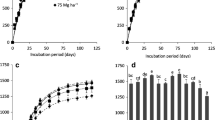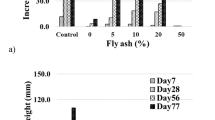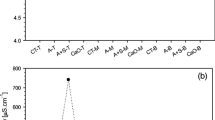Abstract
Purpose
We tested the potential of using coal fly ash for improving the physical and hydrological characteristics of coarse and medium-textured agricultural soils.
Materials and methods
Acidic (FWA) and alkaline (FNSW) fly ashes were used to amend a range of representative agricultural soils. In the first experiment, fly ash was applied to the top 10 cm of 1-m long intact cores of a sandy loam soil at rates of 0, 12, 36 or 108 Mg/ha and sown with canola; after harvest, bulk density (BD), aggregate stability and mean weight diameter (MWD) were measured on the soil. In the second experiment, we assessed water retention at field capacity (−300 kPa) and permanent wilting point (−1,500 kPa) for sandy and loamy soils amended with FNSW at 0.0–16% (w/w). The third experiment used rainfall simulation to assess erodibility of sandy and loamy soils mixed with FNSW at rates of 0, 5 or 20 Mg/ha.
Results and discussion
In the first experiment, fly ash had no significant effect on MWD of the soil. The BD in the 0–10 cm layer (topsoil) was increased with addition of FWA, while FNSW applied at 108 Mg/ha reduced BD, relative to the control treatment. This was because FNSW had lower particle and bulk densities than FWA and the test soils. Ash addition increased macro-aggregation, significantly so in the 10–20 cm layer (subsurface layer), by reducing the percentages of micro-aggregates and silt + clay particles. Thus, macro-aggregation was positively correlated (p < 0.01) with MWD, but both were inversely correlated (p < 0.01) with micro-aggregates. In the second experiment, addition of fly ash enhanced plant water availability by increasing water retention at field capacity by threefold in the sandy soil and 1.5-fold in the loamy sand, but water retention at permanent wilting point was not affected. In Experiment 3, the addition of ash at 20 Mg/ha, but not at 5 Mg/ha, increased turbidity of runoff water from the amended soil due to the dispersal of fine particles by the impact of the simulated raindrops.
Conclusions
Moderate rates of fly ash (<12 Mg/ha or ≤2% w/w) addition can improve aggregation and plant water availability in light to medium-textured soils. Soil applications thus provide a significant end-use for fly ash and can be a part of strategies for minimising environmental footprints from coal-fired power generation. Future studies are needed to further optimise application practices for long-term sustainability.




Similar content being viewed by others
References
Adriano DC, Weber JT (2001) Influence of fly ash on soil physical properties and turfgrass establishment. J Environ Qual 30:596–601
Adriano DC, Page AL, Elseewi AA, Chang AC, Straughan I (1980) Utilization and disposal of fly-ash and other coal residues in terrestrial ecosystems: a review. J Environ Qual 9:333–334
Aitken RL, Campbell DJ, Bell LC (1984) Properties of Australian fly ashes relevant to their agronomic utilisation. Aust J Soil Res 22:443–453
Buchanan SJ, So HB, Kopittke PM, Menzies NW (2010) Influence of texture in bauxite residues on void ratio, water holding characteristics, and penetration resistance. Geoderma 158:421–426
Campbell DJ, Fox WE, Aitken RL, Bell LC (1983) Physical characterization of sands amended with fly ash. Aust J Soil Res 21:147–154
Chang AC, Lund LJ, Page AL, Warneke JE (1977) Physical properties of fly ash-amended soils. J Environ Qual 6:267–270
El-Mogazi D, Lisk DJ, Weinstein LH (1988) A review of chemical, and biological properties of fly ash and effects on environmental ecosystems. Sci Total Environ 74:1–37
Gee GW, Bauder JW (1979) Particle size analysis by hydrometer: a simplified method for routine textural analysis and a sensitivity test of measurement parameters. Soil Sci Soc Am J 43:1004–1007
Ghodrati M, Sims J, Vasilas B, Hendricks S (1995) Enhancing the benefits of fly ash as a soil amendment by pre-leaching. Soil Sci 159:244–252
Gorman JM, Sencindiver JC, Horvath DJ, Singh RN, Keefer RF (2000) Erodibility of fly ash used as a topsoil substitute in mineland reclamation. J Environ Qual 29:805–811
Hartmann P, Fleige H, Horn R (2009) Physical properties of forest soils along a fly-ash deposition gradient in Northeast Germany. Geoderma 150:188–195
Hartmann P, Fleige H, Horn R (2010) Changes in soil physical properties of forest floor horizons due to long-term deposition of lignite fly ash. J Soils Sediments 10:231–239
Heidrich C (2003) Ash (CCP’s) utilisation—an Australian perspective. In: Proceedings of the international ash utilization symposium, CAER, University of Kentucky, Lexington, Kentucky, USA, April 11–15
IEAust (1987) Australian Rainfall and Runoff: A Guide to Flood Estimation, Vol. 1. Engineers Australia, ACT, Australia
Kalra N, Harit RC, Sharma SK (2000) Effect of fly ash incorporation on soil properties of texturally variant soils. Bioresour Technol 75:91–93
Korcak RF (1995) Utilization of coal combustion by-products in agriculture and horticulture. In: Karlen DL, Wright RJ, Kemper WO (eds) Agriculture utilization of urban and industrial By-Products. ACA Special publication 58, USA, pp 107–130
Lehrsch GA, Baker DE (1989) Fly ash erodibility. J Soil Water Conserv 44:624–627
Manoharan V, Yunusa IAM, Loganathan LR, Burchett MD, Murray BR, Skilbeck GC, Eamus D (2010a) Boron contents and solubility in Australian fly ashes and its uptake by canola (Brassica napus L.) from the ash-amended soils. Aust J Soil Res 48:480–487
Manoharan V, Yunusa IAM, Loganathan P, Lawrie R, Skilbeck GC, Burchett MD, Murray BR, Eamus D (2010b) Assessments of Class F fly ashes for amelioration of soil acidity and their influence on growth and uptake of Mo and Se by canola. Fuel 89:3498–3504
Màrquez CO, Garciab VJ, Cambardellac CA, Schultzd RC, Isenhart TM (2004) Aggregate-size stability distribution and soil stability. Soil Sci Soc Am J 68:725–735
Muir MA, Yunusa IAM, Burchett MD, Lawrie R, Chan KY, Manoharan V (2007) Short-term responses of two contrasting species of earthworms in an agricultural soil amended with coal fly-ash. Soil Biol Biochem 397:987–992
Odeh IOA, Onus A (2008) Spatial analysis of soil salinity and sodicity in an irrigated semiarid region of New South Wales, Australia. Environ Manage 42:265–278
Pathan SM, Aylmore LAG, Colmer TD (2003a) Properties-of several fly ash materials in relation to use as soil amendments. J Environ Qual 32:687–693
Pathan SM, Aylmore LAG, Colmer TD (2003b) Soil properties and turf growth on a sandy soil amended with fly ash. Plant Soil 256:103–114
Pudasaini M, Shrestha S (2008a) Rainfall Energy Losses in Presence of Shallow Overland Flow. In: Proceedings of the 9th National Conference on Hydraulics in Water Engineering, 23–26 September 2008, Darwin, NT, Australia
Pudasaini M, Shrestha S (2008b) Estimation of Kinetic Energy-Rainfall Simulation. In: Proceedings of the 9th National Conference on Hydraulics in Water Engineering, 23–26 September 2008, Darwin, NT, Australia
Salé LY, Chanasyk DS, Naeth MA (1997) Temporal influence of flyash on select soil physical properties. Can J Soil Sci 77:677–683
Salter PJ, Berry G, Williams JB (1966) The influence of texture on moisture characteristics of soils. III. Quantitative relationship between particle size composition and available water capacity. J Soil Sci 17:93–97
Shainberg I, Sumner ME, Miller WP, Farina MPW, Pavan MA, Fey MV (1989) Use of gypsum on soils: a review. Adv Soil Sci 9:1–111
Sharma SK, Kalra N (2006) Effect of fly ash incorporation on soil properties and productivity of crops: a review. J Sci Ind Res 65:383–390
Sims JT, Vasilas BL, Ghodrati M (1995) Evaluation of fly ash as a soil amendment for the Atlantic coastal-plain.2. Soil chemical-properties and crop growth. Water Air Soil Poll 81:363–372
Unger PW (1997) Aggregate and organic carbon concentration interrelationships of a Torrertic Paleustoll. Soil Tillage Res 42:95–113
World Coal Institute (2009) Coal statistics. http://www.worldcoal.org/resources/coal-statistics/ . (Accessed: 15 Feb 2010)
Yunusa IAM, Eamus D, DeSilva DL, Murray BR, Burchett MD, Skilbeck GC, Heidrich C (2006) Fly-ash: an exploitable resource for management of Australian agricultural soils. Fuel 85:2337–2344
Yunusa IAM, Burchett MD, Manoharan V, DeSilva DL, Eamus D, Skilbeck GC (2009) Photosynthetic pigment concentration, gas exchange and vegetative growth of selected monocots and dicots treated with contrasting coal fly ashes. J Environ Qual 38:1466–1472
Yunusa IAM, Loganathan P, Nissanka SP, Manoharan V, Burchett MD, Skilbeck CG, Eamus D (2010) Application of coal fly ash in agriculture: a strategic perspective. Crit Rev Environ Sci Technol (in press)
Zhang C, Yao Q, Sun J (2005) Characteristics of particulate matter from emissions of four typical coal-fired power plants in China. Fuel Processing Tech 86:757–768
Acknowledgments
We received highly valued technical assistance from Roy Lawrie and Nawash Hadad at the NSW DPI, Rob Caley and Paul Toner at the University of Western Sydney and Mr Russell Field at the Department of Environment and Geography, Macqurie University. We thank Prof. Damian Gore at the Macquarie University for the use of Laser Particle Size Analyser. We also thank the referees for the time and close attention paid our manuscript and for their very helpful suggestions. This project was funded by the Ash Development Association of Australia and the Australian Research Council (LP04055110), and we appreciate the support given to the research team by Mr Craig Heidrich of ADAA.
Author information
Authors and Affiliations
Corresponding author
Additional information
Responsible editor: Hailong Wang
Rights and permissions
About this article
Cite this article
Yunusa, I.A.M., Manoharan, V., Odeh, I.O.A. et al. Structural and hydrological alterations of soil due to addition of coal fly ash. J Soils Sediments 11, 423–431 (2011). https://doi.org/10.1007/s11368-010-0312-5
Received:
Accepted:
Published:
Issue Date:
DOI: https://doi.org/10.1007/s11368-010-0312-5




